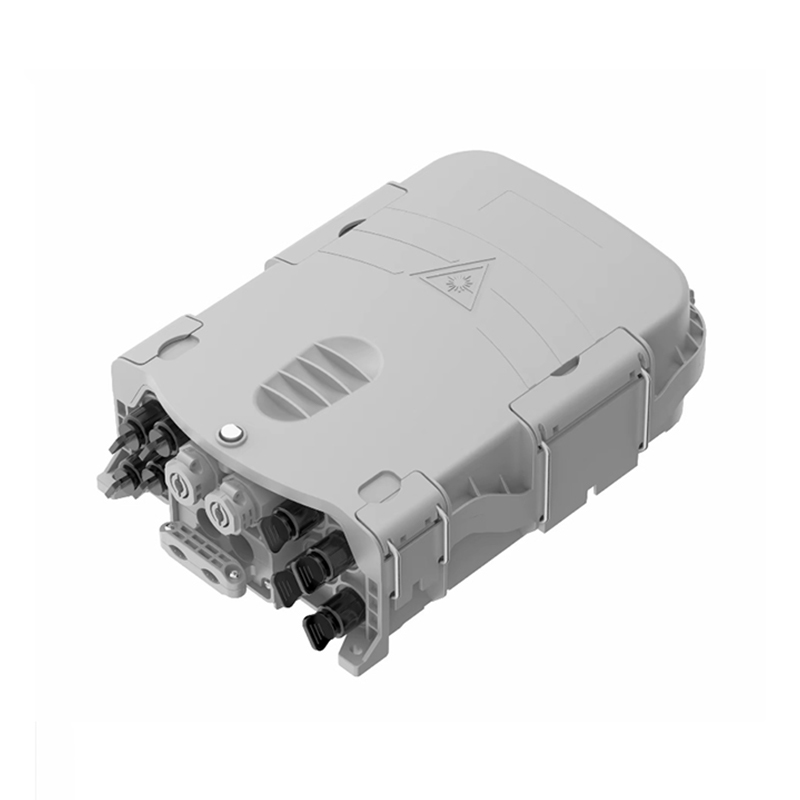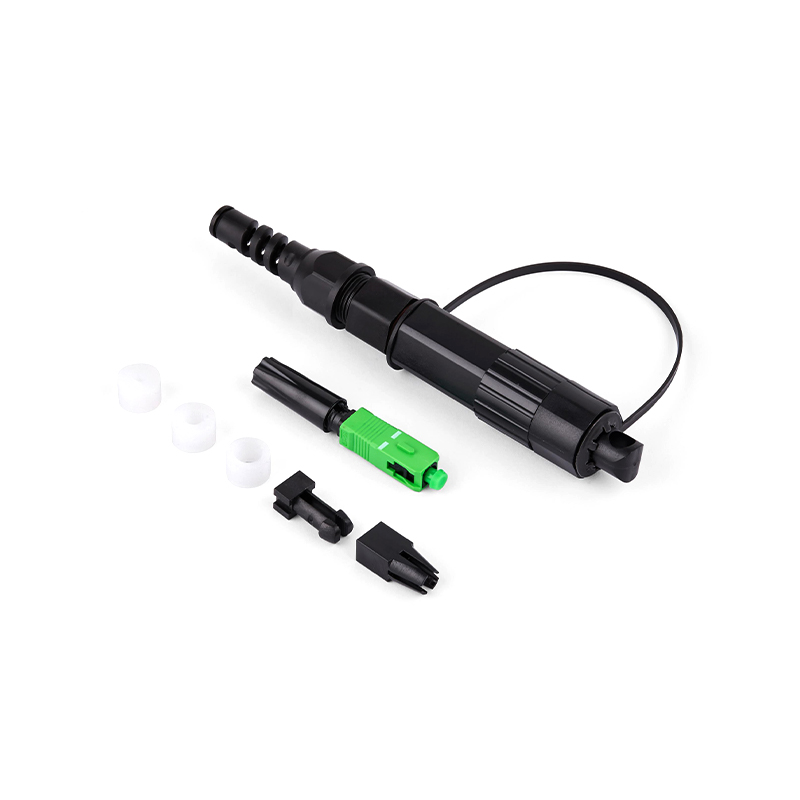SC Series Fiber Optic Fast connector: The Future of Efficient Connectivity
2025-08-01
The SC Series Fiber Optic Quick Connector is a fiber optic connector that mechanically achieves rapid fiber connections and is designed for field splicing of fiber optic cables. It typically features a pre-polished collet and a mechanical splicing mechanism, allowing for fast and reliable fiber splicing.
Developed by NTT Corporation of Japan, the SC connector is a rectangular-shell fiber optic connector used for removable connections between fibers. Its basic structure consists of a ferrule and coupling sleeve, the dimensions of which are the same as those of the FC connector, but the fastening mechanism utilizes a plug-and-latch mechanism, eliminating the need for rotation.
The SC connector's shell is typically made of engineering plastic, with a ceramic zirconium oxide ferrule inside to ensure long-term stability. This connector's design allows for easy operation and compatibility with a variety of fiber types, including single-mode and multimode.
The Importance of Fiber Optic Connectors in Modern Communication Networks
Fiber optic connectors are an essential component of modern communication networks. They connect, secure, and protect optical fibers in fiber optic communication systems, laying the foundation for high-speed, high-capacity, and long-distance data transmission. With the rapid development of information technology, the application range of fiber optic connectors continues to expand, and their importance is growing.
1. The Core Role of Connecting and Securing Fiber Optics
The primary function of fiber optic connectors is to reliably connect two or more optical fibers, enabling optical signals to be transmitted between different devices or line segments. In fiber optic communication systems, fiber optic connectors not only connect but also secure the fibers, preventing breakage or misalignment. Through sophisticated mechanical structures and optical alignment mechanisms, fiber optic connectors ensure low loss and high stability of optical signals during transmission, thereby guaranteeing communication quality.
2. Supporting High-Speed Data Transmission Demand
With the development of emerging technologies such as 5G, the Internet of Things (IoT), cloud computing, and artificial intelligence, the demand for data transmission rates and bandwidth is increasing. As a core component of fiber optic communication systems, fiber optic connectors must possess high bandwidth, low latency, and high reliability. For example, the SC Series Fiber Optic Fast connector utilize mechanical fusion splicing, eliminating the need for heat or adhesives to achieve fast and reliable fiber connections. They are ideally suited for high-speed access scenarios such as FTTH (fiber to the home).
3. Adaptable to Various Application Scenarios
Fiber optic connectors are widely used in various communication network environments, including but not limited to:
Data Centers and Enterprise Networks: In data centers, fiber optic connectors are used for high-speed data transmission between servers, switches, routers, and other devices, and are key to building high-performance network architectures.
Telecommunications Networks: In carrier backbone and metropolitan area networks, fiber optic connectors connect optical cables, optical terminal equipment, and optical transmission equipment, providing the foundation for high-capacity, long-distance communications.
Fiber-to-the-Home (FTTH): In home broadband access, fiber optic connectors connect optical cables to user terminal equipment, playing a crucial role in achieving gigabit and even 10G access.
Surveillance and Security Systems: In video surveillance, traffic management, power monitoring, and other fields, fiber optic connectors are used to build high-definition, real-time video transmission networks.
Industrial Automation and Intelligent Manufacturing: In industrial control, robotics, smart factories, and other fields, fiber optic connectors are used to build highly reliable industrial Ethernet networks and real-time control systems.
4. Improving the Reliability and Maintainability of Communication Systems
The design and manufacturing process of fiber optic connectors directly impacts the stability and maintainability of communication systems. High-quality fiber optic connectors offer low insertion loss, high return loss, and excellent mechanical durability, thereby reducing signal attenuation and reflection interference, improving communication quality. Furthermore, the standardized design and modular structure of fiber optic connectors facilitate installation, maintenance, and replacement, reducing the complexity and cost of network operations.
5. Promoting the Continuous Development of Communication Technology
The continuous improvement of fiber optic connector performance, such as lower insertion loss, higher return loss, smaller size, and more flexible installation methods, has driven the advancement of fiber optic communication technology. For example, the introduction of the SC series fiber optic quick connector not only simplifies the fiber splicing process, but also improves installation efficiency and reduces deployment costs, providing strong support for the popularization and application of fiber optic communication technology.
6. Compliance with International Standards and Industry Specifications
To ensure the compatibility and interoperability of fiber optic connectors, a series of relevant international standards have been established, such as TIA/EIA-604-3, IEC 61754, and GB/T 17650. These standards clearly define the dimensions, performance, and testing methods of fiber optic connectors, ensuring compatibility between products from different manufacturers and promoting the healthy development of the fiber optic communication industry.
Comparison of SC Connectors with Other Connector Types (such as LC, FC, and ST)
SC connectors differ significantly from other connector types (such as LC, FC, and ST) in terms of structure, performance, and application scenarios. The following is a detailed comparison:
1. Structure and Appearance
SC connectors: The housing is rectangular, pluggable, and features a snap-on design. They are relatively large, approximately 28mm long and 15mm wide, and are typically blue or gray.
LC connectors: Smaller than SC connectors, the LC connector is a compact rectangle, approximately 15mm long and 8mm wide, and is typically yellow. Using a modular jack (RJ) latch mechanism, the LC connector plugs similarly to the SC connector, but is more compact.
FC connectors: Round in appearance, with a threaded connection, approximately 12mm in diameter and 30mm in length, and are typically green.
ST connectors: Round in appearance, with a screw-on fastening mechanism and a half-turn locking mechanism, they are suitable for multimode fiber systems.
2. Performance Characteristics
SC Connector: Offers excellent interchangeability and repeatability, with insertion loss within 0.3dB and return loss exceeding 40dB, making it suitable for frequent plugging and unplugging.
LC Connector: Compact, with insertion loss within 0.25dB and return loss exceeding 55dB. Its push-pull plug-in operation saves space and is suitable for high-density cabling environments.
FC Connector: Offers a secure, threaded connection with insertion loss around 0.2dB and return loss exceeding 50dB, making it suitable for environments requiring high stability.
ST Connector: Easy to install but prone to removal, suitable for low-speed transmission environments such as campus networks and building area networks.
3. Application Scenarios
SC Connector: Widely used in telecom operator network construction, cable TV networks, and enterprise campus networks, such as FTTB and FTTH access networks, connecting optical modems, splitters, and other equipment.
LC Connector: Suitable for connecting servers and switches within data centers and connecting ports on fiber optic distribution frames. It is suitable for high-density cabling scenarios, such as the fiber cabling needs of expanding data centers.
FC connectors: Used for connecting long-distance communication trunk lines and core equipment in computer rooms, ensuring stable optical signal transmission, such as in intercity long-distance fiber-optic transmission networks and core switching equipment in large data centers.
ST connectors: Commonly used in fiber-optic patch panels, their disadvantage is that they are prone to breakage, damaging the connection points and affecting the quality of fiber-optic communications.
4. Advantages and Disadvantages
SC connectors: Advantages include ease of operation, low price, easy plugging and unplugging, minimal insertion loss fluctuation, high compressive strength, and high installation density; disadvantages include ease of detachment.
LC connectors: Advantages include small size, suitable for high-density cabling, and easy push-pull plugging and unplugging; disadvantages include a complex manufacturing process and potentially higher cost.
FC connectors: Advantages include a secure connection and good dustproofing, suitable for applications requiring tighter connections; disadvantages include a relatively complex installation process.
ST connectors: Advantages include ease of installation and suitability for low-speed transmission environments; disadvantages include ease of detachment and unsuitability for high-density cabling.











